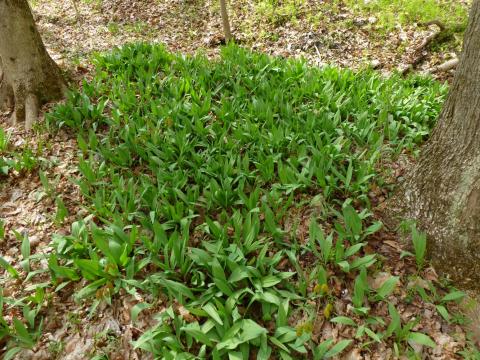Is it possible to grow ramps in the garden?

Ramps (Allium tricoccum), otherwise known as wild leeks, are native perennial wildflowers commonly harvested as wild food. With a distinctive flavor somewhere between garlic and mild onion, ramps are considered a spring delicacy. For a few short weeks after the snow melts, ramps dishes can be found at upscale restaurants and occasional farmers markets throughout the northeast. Ramps are so highly sought that they are one of the most over-harvested wild edibles. They grow slowly and it takes a long time for wild populations to recover if a forager takes too many.
Through present throughout New Hampshire, they are quite rare. In terms of conservation status, one particular variety (Allium tricoccum var. burdickii), is considered in danger of going extinct. The good news is that it is possible for ramps lovers to grow this wild perennial in their own gardens.
Like other members of the onion family, ramps grow from underground bulbs. In the early spring, the bulbs send up two long, glossy, oval leaves that smell oniony when torn or bruised. The leaves grow to about six to eight inches tall and three inches wide before dying back in the early summer, just as the leaves begin to come out on the trees overhead. The foliage and bulbs are the edible parts of the plant and must be harvested before the leaves go dormant. After the foliage has faded, six-to-ten-inch bare flowering stalks emerge from the ground, topped with small white flowers in globular clusters.
Where Ramps Grow
In the wild, ramps grow in rich, moist, woodlands that are dominated by deciduous tree species such as maple, beech or oak. Soils with a pH closer to neutral (6.8-7.2) are most suitable for growth, thus ramps are often found growing in proximity to other wildflowers that prefer more alkaline soils, such as bloodroot (Sanguinaria canadensis), trout lily (Erythronium americanum) and Dutchman’s breeches (Dicentra cucullaria). In order to grow ramps successfully in the garden, similar growing conditions must be provided. The perfect planting bed is located in full-to-partial shade with highly organic, consistently moist soil and an approximately neutral pH. Ramps are right at home in a woodland or naturalized shade garden with plenty of added compost and leaf mulch.
How To Grow Ramps
Ramps can be grown from seed, transplants or divisions. Ramps are very slow growing compared with other onion crops. Growing your own plants from seed is the thriftiest way to add ramps to the garden, but it takes patience. It can take a year or more for seed to germinate and another 7-10 years for the plant to reach maturity.
Ramps seeds have a dormancy mechanism that must be broken to get them to germinate. They must undergo an extended cool, wet period in order for them to sprout. Planting the seed in the fall exposes it to the necessary cold weathering over the winter, and it will germinate in succeeding growing seasons.
A quicker way to get the seeds to germinate is to pack them in moist vermiculite in a sealed plastic bag, store them in a room temperature location for two to three months, then move them to the refrigerator for an additional two to three months. After this treatment, the seeds can be sown in the spring.
If you’re not willing to wait for years to harvest, ramps can also be purchased as bare-root plants and planted in either spring or fall. While it may still take a couple of years before the ramps are big enough to harvest, results are more easily guaranteed.
Harvesting ramps takes a little care in order to maintain a stable population. Though the bulbs are often considered the best eating, digging them up clearly kills the entire plant. Harvesting only the foliage is a more sustainable way of keeping ramps in the garden from season to season. Removing only a single leaf from each plant is the most effective way of keeping the bulbs healthy and growing. Removing all of the foliage won’t necessarily kill the plants, but it can weaken them by cutting down on photosynthesis.
Photo by Wendell Smith (CC by 2.0)
Do you love learning about stuff like this?
SUBSCRIBE TO Granite State Gardening newsletter
Got questions? The UNH Extension Yard and Garden Infoline offers practical help finding answers for your yard and garden questions.
Call toll free at 1-877-398-4769, Monday to Friday, 9 a.m. to 2 p.m., or fill out webform.
